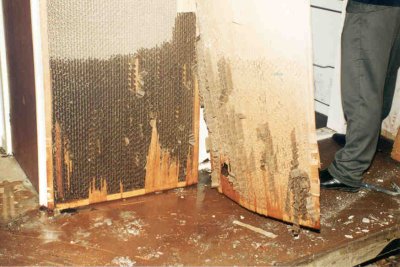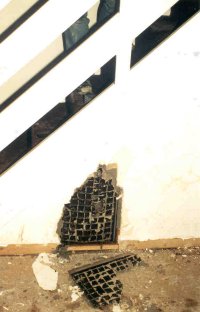

home > what to do > repairs > wood
 A
hollow core door damaged by flooding (photo courtesy of WA Fairhurst &
Partners, Dundee)
A
hollow core door damaged by flooding (photo courtesy of WA Fairhurst &
Partners, Dundee)
Decay of wood is unlikely if the wood dries out within a few weeks. However, if the wood remains damp for longer periods of time then the threat of decay becomes greater. With wood framed walls, it is essential to expose any wood up to the tide mark (highest level of flood water), removing plasterboards, vapour control membranes and insulation unless the flooding was very limited (only lasting a few hours), less than 150mm or 6" and the moisture content of the wood is less than 20%. Any specialists will have a moisture meter that can be used to measure the moisture content of the wood and they should be contacted if you are in any doubt over damage to your property.
Wooden window frames may jam when wet (due to expansion after water absorption) and become distorted as they dry. The distortion may cause the frame’s paint to flake off. Therefore check the moisture content of the wood and also check for signs of rot. If necessary, repair and treat the wet timber with preservative plugs. Once dry, the frames can be redecorated.
Wooden staircases may become unstable and weakened, so check the support of the staircase and, if necessary, strengthen it with extra struts under the floor. Stabilise loose treads once the staircase has dried out.
Fire doors are often constructed with layers of fire resistant compound hidden in their cores. Soaking in water can permanently damage these doors. Replace all fire doors that have been immersed in floodwaters.
Remove plinths from floor-mounted cupboards and kitchen units and dry out, clean and disinfect the void and the area behind the cupboards. Cupboards and kitchen units are frequently made of laminated chipboard which can be severely damaged by flooding. The chipboard may expand or distort and loose its strength and can also be impossible to disinfect properly. If this is the case the units will need to be disposed of and should be replaced. If there is a risk that flooding may re-occur, consider replacing laminated chipboard units with those made from materials less vulnerable to damage.
 Examine
the condition of stairs carefully (photo courtesy of WA Fairhurst & Partners,
Dundee)
Examine
the condition of stairs carefully (photo courtesy of WA Fairhurst & Partners,
Dundee)
20 November 2002